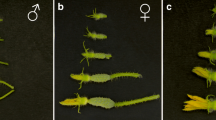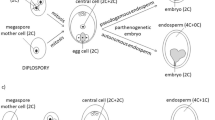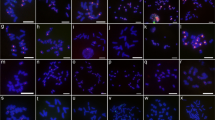Abstract
Determining the base number, ploidy level and type of ploidy are important aspects in the cytogenetic study of a species. To assess the nature of Allium hookeri Thwaites (2n=22), chromosomes of its two populations from North-eastern Himalayas were worked out for morphological details, putative grouping and pairing properties during reduction division. Karyotype was found to split into 7 pairs and 8 single chromosomes; 7 pairs revealed minor differences in overall chromosome morphology. Critical analysis of chromosome behaviour during reduction division at diakinesis and metaphase I revealed the presence of trivalents in 60.5 and 58.5% pollen mother cells respectively. High frequency of cells with trivalents pointed towards considerable homology in three genomes. Though remaining cells had multivalents higher than trivalents, similarity in three genomes was there. High frequency of cells with trivalents and the fact that 22 chromosomes can be arranged in seven twos and eight ones indicated that these represent numerical variants of segmental allotriploids. Besides, occurrence of 29.8 and 17.6% chromosomes as multivalents higher than trivalents at diakinesis and metaphase I supported that multiple interchanges accompanied the polyploidy in the evolution of present cytotypes. Pairing anomalies noticed during meiosis result in very low pollen stainability (0.05%) leading to sterility. Propagation by bulbs ensures the survival and maintenance of such a complex heterozygosity in the species.


Similar content being viewed by others
References
Bennett ST, Kenton AY, Bennett MD (1992) Genomic in situ hybridisation differentiates between A/D- and C- genome chromatin and detects intergenomic translocations in polyploid oat species (genus Avena). Genome 37:613–618
Cleland R (1972) Oenothera: cytogenetics and evolution. Academic Press, London
Gaut BS, Doebley JF (1997) DNA sequence evidence for the segmental allotetraploid origin of maize. Proc Natl Acad Sci 94:6808–6814
Hooker JD (1892) The flora of British India, vol VI. L. Reeve and Co., London
James SH (1965) Complex hybridity in Isotoma petraea. I. The occurrence of interchange heterozygosity, autogamy and balanced lethal system. Heredity 20:341–353
Jamilena M, Rejon CR, Rejon MR (1990) Variation in the heterochromatin and nucleolar organizing regions of Allium subvillosum L. (Liliaceae). Genome 33:779–784
Jellen EN, Gill BS, Cox TS (1994) Genomic in situ hybridization revealed allopolyploid nature of Milium montianum (Gramineae). Chromosoma 101:420–424
Jha TB, Jha S (1989) In vitro regeneration and cytological study of Allium hookeri Thw. Indian J Exp Biol 27:363–365
Kala CP (2005) Ethnomedicinal botany of the Apatani in the Eastern Himalayan region of India. J Ethnobiol Ethnomed 1:1–8
Koul AK, Gohil RN (1971) Further studies on natural triploidy in viviparous onion. Cytologia 36(2):253–261
Koul AK, Sharma MC, Gohil RN (1969) Cytology of the tetraploid Allium rubellum Bieb. Caryologia 24(2):149–155
Levy AA, Feldman M (2002) The impact of polyploidy on grass genome evolution. Plant Physiol 130:1587–1593
Meimberg H, Rice KJ, Milan NF, Nijoku CC, Mackay JK (2009) Multiple origins promote ecological amplitude of allopolyploid Aegilops (Poaceae). Am J Bot 96(7):1262–1273
Pandey A, Pandey R, Negi KS, Radhamani J (2008) Realizing value of genetic resources of Allium in India. Genet Resour Crop Evol 55:985–994
Rui-Fu H, Rong-Cheng WEI, Jie-Mei X (1996) A study of karyotypes on Allium hookeri and its variety Allium hookeri var. muliense. Acta Bot Yunnan 8:78–84
Samoylov A, Friesen N, Pollner S, Hanelt P (2008) Use of chloroplast DNA polymorphisms for the phylogenetic study of Allium subgenus Amerallium and subgenus Bromatorrhiza (Alliaceae) II. Feddes Repert 110:103–109
Sen S (1974) Cryptic structural changes in the evolution of cultivated Alliums. Indian J Hered 8:41–50
Sharma G, Gohil RN (2008) Intrapopulation karyotypic variability in Allium roylei Stearn – a threatened species. Bot J Linn Soc 158:242–248
Singh F, Ved Brat S, Khoshoo TN (1969) Natural triploidy in viviparous onions. Cytologia 32:403–407
Singh HB, Singh RS, Sandhu JS (2003) Herbal medicine of Manipur–A colour encyclopaedia. Daya Publishing House, Delhi
Song K, Lu P, Tang K, Osborn TC (1995) Rapid genome change in synthetic polyploids of Brassica and its implications for polyploid evolution. Proc Natl Acad Sci 92:7719–7723
Stebbins GL (1971) Chromosomal evolution in higher plants. Edward Arnold, London
Truco MJ, Hu J, Sadowski J, Quiros CF (1996) Inter- and intragenomic homology of the Brassica genomes: implications for their origin and evolution. Theor Appl Genet 93:1225–1233
Tzanoudakis D, Vosa CG (1988) The cytogeographical distribution pattern of Allium (Alliaceae) in the Greek Peninsula and Islands. Plant Syst Evol 159:193–215
Wendel JF (2000) Genome evolution in polyploids. Plant Mol Biol 42:225–249
Yi-Xiang Y, Rui-Fu H, Rong-Cheng W, Jie-Mei X (1990) Studies on the karyotypes of 5 samples of Allium sect. Bromatorrhiza Ekberg. Acta Phytotaxonomica Sinica 28:177–184
Acknowledgments
The authors are grateful to the Head, Department of Botany, University of Jammu, Jammu for providing the necessary facilities and National Bureau of Plant Genetic Resources (Bhowali) for providing the plant material. Council of Scientific and Industrial Research, Govt. of India, New Delhi is also gratefully acknowledged for providing financial assistance to the first author.
Author information
Authors and Affiliations
Corresponding author
Rights and permissions
About this article
Cite this article
Sharma, G., Gohil, R.N. & Kaul, V. Cytological status of Allium hookeri Thwaites (2n = 22). Genet Resour Crop Evol 58, 1041–1050 (2011). https://doi.org/10.1007/s10722-010-9641-x
Received:
Accepted:
Published:
Issue Date:
DOI: https://doi.org/10.1007/s10722-010-9641-x




